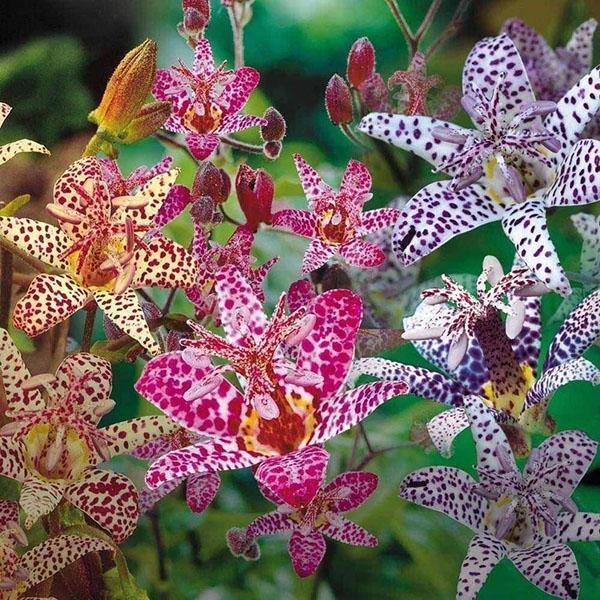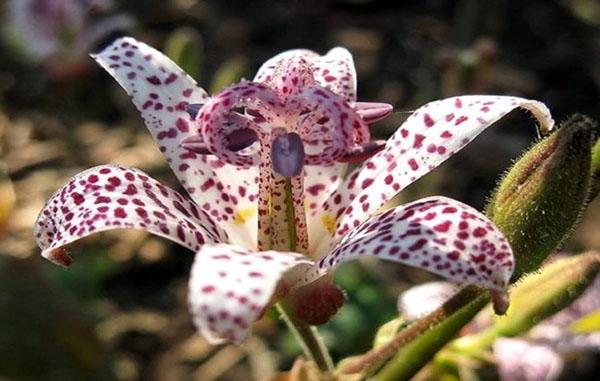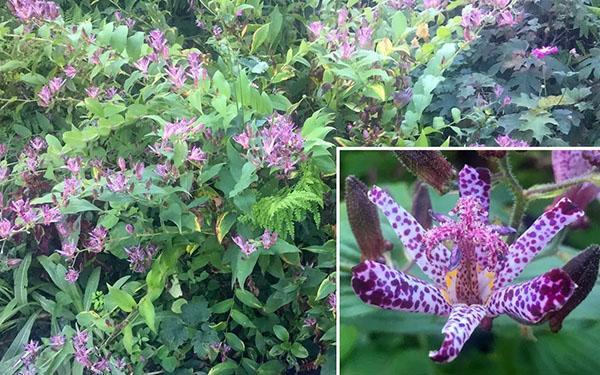Tricirtis garden orchid: cultivation skills and variety portfolio
 Extravagant leopard prints have not left the fashion catwalks for more than half a century. The garden orchid tricirtis is an original exhibit for a garden in this design. In addition to the golden hue, the portfolio of this flower family includes purple, pink, black and sky blue tones.
Extravagant leopard prints have not left the fashion catwalks for more than half a century. The garden orchid tricirtis is an original exhibit for a garden in this design. In addition to the golden hue, the portfolio of this flower family includes purple, pink, black and sky blue tones.
Ferns, trilliums, lilies, and hosts grow in the same conditions as variegated perennials. Therefore, they feel much better in their company than without them.
Gardeners note that such specimens are rare "guests" in the household plots of northern latitudes. Although they are resistant to disease, they are still very “capricious” in cultivation.
Garden orchid tricirtis: professional planting

Thin stems are crowned with luxurious flowers, striking:
- ovoid and oblong (up to 4 cm);
- large petals with bright blotches;
- terry center in the form of a miniature fountain;
- ripe seeds that hide in secret capsules;
- a variety of color palette: from cream to dark purple.
Since the crop is native to the tropics, its foliage gets burned from direct sunlight. For successful growth, she will need forest soil or black soil. On clay soil, the plant dies due to stagnant moisture.
Amazing tricyrtis flowers can boast of such external data. Care and planting for them requires special preparation. The first step is to determine where to plant garden orchids.
Due to their whimsical nature, they are placed:
- in elevated places, as much as possible protected from drafts;
- under the openwork crown of large trees;
- on loose soil rich in peat and humus.
 Seeds are sown immediately after harvest, that is, in winter. Before planting, the site is dug up together with deciduous or rotted manure. Fertilizers are applied in small quantities. Small grooves are made, the embedding depth is 0.3 cm. Then they are sprinkled with earth and poured abundantly with warm rainwater.
Seeds are sown immediately after harvest, that is, in winter. Before planting, the site is dug up together with deciduous or rotted manure. Fertilizers are applied in small quantities. Small grooves are made, the embedding depth is 0.3 cm. Then they are sprinkled with earth and poured abundantly with warm rainwater.
Often, bad weather conditions make it difficult to plant on time. Then it is postponed until spring. In this situation, the seeds need to be stratified: they are placed in a refrigerator for 6-8 weeks, after which they are planted.
The art of caring
 Planting tricyrtis in the open ground and caring for them comes down to creating natural living conditions. A favorable temperature for growing a garden orchid is + 15 ° C. In this case, fluctuations up to 5 ° C are allowed both up and down the mercury column. However, it is almost impossible to keep track of the ongoing changes. Therefore, it is worth knowing that the culture develops well in unusual conditions, if the air humidity remains within 80-85%.
Planting tricyrtis in the open ground and caring for them comes down to creating natural living conditions. A favorable temperature for growing a garden orchid is + 15 ° C. In this case, fluctuations up to 5 ° C are allowed both up and down the mercury column. However, it is almost impossible to keep track of the ongoing changes. Therefore, it is worth knowing that the culture develops well in unusual conditions, if the air humidity remains within 80-85%.
This requirement can be met in the following way:
- on time, as well as water the flower bed abundantly;
- loosen moist soil;
- remove weeds;
- cover the site mulch from compost or humus.
In no case should you use fresh manure for your front garden.The active substances contained in it are capable of burning the superficial root system of flowers.
 For watering it is advised to use drip irrigation system... Among other things, gardeners moisten the soil with watering cans, pouring water to the very root. In this case, it is important to ensure that the site does not become waterlogged.
For watering it is advised to use drip irrigation system... Among other things, gardeners moisten the soil with watering cans, pouring water to the very root. In this case, it is important to ensure that the site does not become waterlogged.
Organic fertilizers, as well as mineral complexes, are used as top dressing. With proper cultivation and care, tricyrtis should discard buds at 2 or 3 years of age. In dry summers, the bushes are recommended to be sprayed with cool water. Nevertheless, the temperature of the liquid should be 5-10 ° C lower than that of air.
Winter, cold, lonely flowers
 Breeders have bred several varieties of crops that are resistant to abnormal temperatures (-20 ° C). Among them, there are varieties such as short-haired and broad-leaved. Nevertheless, it is advised to cover the bed with a dense layer of agrofibre, foliage or peat. Some mulch the site well. When the winter is too snowy, farmers build a decent shelter from the snow for their flowers.
Breeders have bred several varieties of crops that are resistant to abnormal temperatures (-20 ° C). Among them, there are varieties such as short-haired and broad-leaved. Nevertheless, it is advised to cover the bed with a dense layer of agrofibre, foliage or peat. Some mulch the site well. When the winter is too snowy, farmers build a decent shelter from the snow for their flowers.
Residents of the southern regions grow tricyrtis garden orchids in containers, sowing seeds in early March. As soon as it gets warm outside, they take the pots out into the fresh air.
The mysterious world of rare tricyrtis
 Currently, 10 varieties of exotic culture are known. As noted earlier, some varieties are winter hardy, while others die even under cover. Yet they love well-fertilized soil and a humid microclimate. It's time to get to know some of them.
Currently, 10 varieties of exotic culture are known. As noted earlier, some varieties are winter hardy, while others die even under cover. Yet they love well-fertilized soil and a humid microclimate. It's time to get to know some of them.
Tricirtis Hirta or Short-haired
 Natural habitat - Japan. The cultivated variety grows up to 60-80 cm, and in the wild - up to 1.5 m. On the cylindrical shoots there are large oval leaves with depressed veins. Sometimes deciduous plates reach 15-17 cm in length and 5 cm in width. The plant has a slight pubescence, which is why it is called tricyrtis Short-haired.
Natural habitat - Japan. The cultivated variety grows up to 60-80 cm, and in the wild - up to 1.5 m. On the cylindrical shoots there are large oval leaves with depressed veins. Sometimes deciduous plates reach 15-17 cm in length and 5 cm in width. The plant has a slight pubescence, which is why it is called tricyrtis Short-haired.
 The stems are crowned with luxurious leopard inflorescences that also grow in the leaf axils. The petals, snow-white with a pink tint, are covered with sparsely planted spots of various shapes and sizes. They come in a dark pink or purple hue.
The stems are crowned with luxurious leopard inflorescences that also grow in the leaf axils. The petals, snow-white with a pink tint, are covered with sparsely planted spots of various shapes and sizes. They come in a dark pink or purple hue.
The first buds appear in mid-August and delight with their beauty until the first frost.
Growing and caring for Hirt's tricyrtis is no different from all other members of their family. Still, it should be borne in mind that a significant number of shoots will grow in the upper layers of the soil. Therefore, when weeding the front garden, the hoe does not need to be too deep so as not to damage the root system.
Beauty lessons from the variety Purple Beauty
 This is another frost-resistant variety. The flower plant is the smallest among its "relatives". The bush grows up to 30 cm, and in the best case - 40-50 cm. Refined flower stalks are covered with small flowers that have the following features:
This is another frost-resistant variety. The flower plant is the smallest among its "relatives". The bush grows up to 30 cm, and in the best case - 40-50 cm. Refined flower stalks are covered with small flowers that have the following features:
- snow-white petals are densely covered with purple blotches;
- a variegated heart of a red hue rises majestically above the flower;
- at the base of the petals, the yellow center burns with a bright fire;
- each stem is covered with fine villi.
An exotic flower will delight passers-by with its appearance, if you carefully follow the basic rules for planting and caring for tricyrtis. You can buy Purple Beauty seeds in specialized stores in megacities, since this variety is very rare.
Of course, as an option, planting material can be found on the Internet. However, you should always be prepared for the wrong variety or poor quality seeds being sealed in the package.
 Tricyrtis "Dark Beauty" has a similar botanical description. The only difference of this flower is the darker color of the spots on the petals. To a greater extent, the blotches stand out in muted shades of pink and crimson tones.
Tricyrtis "Dark Beauty" has a similar botanical description. The only difference of this flower is the darker color of the spots on the petals. To a greater extent, the blotches stand out in muted shades of pink and crimson tones.
The uniqueness of the Formazana variety
 It can be found under the names Formosan or Taiwanese.The culture is famous for the unusual structure of flowers:
It can be found under the names Formosan or Taiwanese.The culture is famous for the unusual structure of flowers:
- 3 of 6 petals have an elongated shape and a terry tip;
- the other three leaves are presented in the form of oval plates with a purple tint;
- the red core is covered with thorns;
- a bright circle of fiery yellow color is drawn at its base.
Such an unusual texture can be seen on one of the Formosana tricyrtis hybrids. Other representatives of the variety are distinguished by petals covered with burgundy spots, both small and large. The unusual emptiness of buds and stems gives the culture an exotic charm.
The tricirtis garden orchid is a rarity in the northern hemisphere. Indeed, its cultivation requires high humidity (85%) and a stable temperature (15-20 ° C). The flower dies in swampy and loamy soil. Therefore, if you do not show a painstaking attitude towards him, he will not even rise.